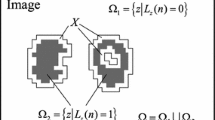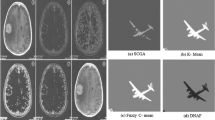Abstract
Since the infrared detector itself is subject to various external disturbances when collecting information, infrared images are characterized by of low SNR, low contrast and blur edge, which greatly increases the difficulty of detection and recognition. Contraposing the problems that a fuzzy clustering algorithm cannot find the reasonable clustering number adaptively, it will have a low infrared image segmentation rate when the gray-scale between object region and background region are of great difference. A gray-scale adaptive fuzzy clustering algorithm (GAFC) is proposed in this work. The methodology uses a coarse-fine concept to reduce the computational burden required for the fuzzy clustering and to improve the accuracy of segmentation that a single fuzzy clustering cannot reach. The coarse segmentation attempts to segment coarsely based on gray level histogram. Firstly, the pseudo peaks in the gray level histogram are removed by introducing a control factor of peak areas and a control factor of peak widths, then in order to find a finer segmentation result, the coarse segmentation result is clustered by an improved fuzzy clustering algorithm that introduces an adaptive function to get the most reasonable cluster number and that defines a logarithmic function as a measurement of distance. The results of experimental data show that not only the GAFC mentioned in this paper preserves the advantages in multi-threshold segmentation method which is fast and easy, and behaves well in segmenting infrared images in complex environments.






Similar content being viewed by others
References
Balla-Arabé S, Gao XB, Wang B (2013) A Fast and Robust Level Set Method for Image Segmentation Using Fuzzy Clustering and Lattice Boltzmann Method. IEEE Trans Cybern 43(3):910–920
Chabrier, S., Laurent, H., Rosenberger, C., Zhang, Y.J.: (2006) Supervised Evaluation of Synthetic and Real Contour Segmentation Results, In: 14th European Signal Processing Conference, pp. 1143–1146, Florence
Chen H.P., Shen X.J., Long J.W. (2015) Histogram-based colour image fuzzy clustering algorithm. Multimedia Tools and Applications, 1–16, Springer, New York
Cui ZH, Sun, Chen SG, Gao LQ (2014) Mean shift based FCM image segmentation algorithm. J control Decis 29(6):1130–1134
Harris C, Stephens M. (1988) A Combined Corner and Edge Detection[C]. Proceedings of the Fourth Alvey Vision Conference, The Plessey Company pic, London, 147–151.
Kubassova O., Boesen M., Bliddal H. (2008) General Framework for Unsupervised Evaluation of Quality of Segmentation Results. In: 15th IEEE International Conference on Image Processing, pp. 3036–3039, San Diego
Li Y, Yu FS (2009) A New Validity Function for Fuzzy Clustering. In: 9th IEEE International Conference on Computational Intelligence and Natural Computing. IEEE Press, Wuhan, pp. 462–465
Li JS, Yang W, Zhang XM (2009) Infrared Image Processing, Analysis and Fusion. Science press, Beijing
Li JP, Fu LQ, Han Y (2010) A Method of Object Segmentation in Complex Environment. Journal of Projectiles, Rockets, Missiles and Guidance 30(4):197–200
Lim YW, Lee SU (1990) On the color image segmentation algorithm based on the Thresholding and the fuzzy C-means techniques. Pattern Recogn 23(9):935–952
Du X.C, Liu J.P. The infrared image segmentation method based on two-dimensional OTSU and genetic algorithm. Infrared Technology 27(1): 66–69 (2005)
Liu J., Wang H.Y., Wang S.H. Infrared image segmentation using adaptive FCM algorithm based on potential function. TELKOMNIKA Indonesian J Electr Eng 12(8): 6230–6237(2014)
Lopes N V, Couto P A, Bustince H, et al. Automatic histogram threshold using fuzzy measures[J]. IEEE Trans Image Process 19(1): 199–204 (2010)
Medina C R, Carmona P A, Determining hysteresis thresholds for edge detection by combining the advantages and disadvantages of Thresholding methods[J]. IEEE Trans Image Process 19(1): 165–173 (2010)
Pedrycz W (2005) Knowledge-based Clustering: from Data to Information Granules. John Wiley & Sons, Hoboken
Tan HB, Hou ZQ, Liu R (2010) Region growing image segmentation based on human visual model. J Image and Graphics 15(9):1352–1356
Tang Q (2010) Threshold segmentation and the infrared image pedestrian detection research[D]. South China University of Technology, Guangzhou
Tao TF, Han CZ, Dai XF (2004) Integrated edge detection and region growing method of infrared image segmentation[J]. Photoelectric Engineering 31(10):50–52
The OTCBVS Benchmark Dataset (2004) http://www.vcipl.okstate.edu/otcbvs/bench/
Unnikrishnan R, Pantofaru C, Hebert M (2007) Toward objective evaluation of image segmentation algorithms. IEEE Trans Pattern Anal Mach Intell 29(6):929–944
Wang SH (2013) Research on Methods for Infrared Image Target Segmentation. Xidian University, Xi’an
Wang HY (2014) Research on Image Target Segmentation Methods Based on Clustering. Xidian University, Xi’an
Wang L, Yung N H C. Extraction of moving objects from their background based on multiple adaptive thresholds and boundary evaluation[J]. IEEE Trans Intell Transp Syst 11(1): 40–51(2010)
Witkin AP (1984) Scale-space filtering: A New Approach to Multi-scale Description. In: IEEE International Conference on Acoustics, Speech, and Signal Processing. IEEE Press, California, pp. 150–153
Wu KL, Yang MS (2002) Alternative c-means clustering algorithms. Pattern Recogn 35(10):2267–2278
Wu R, Huang JH, Tang XL (2009) Based on the gray-level histogram and spectral clustering text image binarization method[J]. Journal of Electronics and Information 31(10):2460–2464
Xie XL, Beni G (1991) A validity measure for fuzzy clustering. IEEE Trans Pattern Anal Mach Intell 13(8):841–847
Xu LP (2007) Digital Image Processing. Science Press, Beijing
Acknowledgments
This research was supported in part by the National Natural Science Foundation of China (Grant No. 61101246) and the Fundamental Research Funds for the Central Universities (Grant No. JB150209).
Author information
Authors and Affiliations
Corresponding author
Rights and permissions
About this article
Cite this article
Liu, J., Liu, Y. & Ge, Q. Infrared image segmentation based on gray-scale adaptive fuzzy clustering algorithm. Multimed Tools Appl 76, 11111–11125 (2017). https://doi.org/10.1007/s11042-016-3657-y
Received:
Revised:
Accepted:
Published:
Issue Date:
DOI: https://doi.org/10.1007/s11042-016-3657-y




